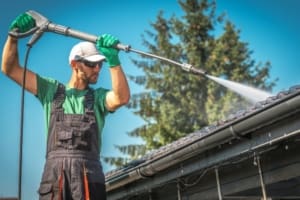Roof Algae: The Importance of Effective Removal
Your roof is one of the most important parts of your home, not just because it keeps you dry and protects your interior but because it also significantly impacts your home’s appearance. Over time, however, moss and algae make your roof look unsightly and cause severe damage if left unchecked. This comprehensive guide will take a closer look at roof algae, the different methods for removing it, and what you need to know to keep your roof in great shape for years to come.
What is Roof Algae?
Roof algae refer to the growth of fungi such as algae, moss, and lichen on roofing materials. These fungi thrive in moist environments and can develop on roofing materials that trap moisture. The presence of roof algae can negatively impact the appearance and longevity of your roof, making it important to address. Moss and lichen can develop on your roof when the conditions are favorable for their growth. This typically occurs when moisture is present on the roofing material. Moisture can come from a variety of sources, including rain, dew, and condensation. The presence of shade and warm temperatures can also increase the likelihood of moss and lichen growth. In some cases, moss and lichen can be carried onto your roof through the wind or through other means, such as birds or insects.
Why is Roof Algae Removal Important?
Moss and lichen removal is important for several reasons. First and foremost, it helps to maintain the appearance of your roof, making it look new and fresh. Second, moss and lichen removal helps prevent roof deterioration, which can extend your roof’s life and prevent costly repairs. And finally, some types of roof algae can be toxic, so removing it can help to keep you and your family safe.
Top 5 Methods for Effective Algae Removal
When it comes to removing moss and lichen, there are several different methods to choose from. Below, we’ll look closely at the top 5 effective moss and lichen removal methods.
Method 1: Power Washing

Power washing is a quick and efficient method for removing moss and lichen, but it should only be performed by a professional. High-pressure water can blast away even the most stubborn algae growth. Power washing can thoroughly clean the roof and prevent future growth, but it can also cause damage to delicate roofing materials and cause leaks if not done correctly. This method is best for roofs in good condition and should not be done during or immediately after rain.
Method 2: Chemical Cleaners

Chemical cleaners are convenient for homeowners looking to remove moss and lichen themselves. These cleaners dissolve the organic material of the algae, making it easy to wash away with water. Chemical cleaners can be effective for smaller roofs or limited mobility but can also be hazardous, toxic, and cause damage to some roofing materials. They should not be used near plants or vegetation.
Method 3: Scrubbing with a Brush

Scrubbing the affected areas with a stiff-bristled brush can effectively remove moss and lichen. This method is best for those comfortable working at heights and can effectively remove stubborn algae growths. However, it is cost-effective but physically demanding and can be time-consuming for larger roofs. This method can also cause damage to some roofing materials and may not be effective for certain types of roof algae.
Method 4: Copper or Zinc Strips

Copper or zinc strips can prevent new moss and lichen growth by releasing small amounts of copper or zinc ions that act as deterrents. This method does not remove existing algae but is a cost-effective and low-maintenance solution. Strips are typically installed along the roof’s ridge line, where they come into contact with rainwater. However, this method may take longer to see results and may not be effective for certain types of roof algae.
Method 5: Algae-Resistant Roof Shingles

Installing algae-resistant roof shingles is a long-term solution for preventing roof algae growth. These shingles contain a special granule that releases zinc oxide, a deterrent for algae. The benefits of choosing this method include a long-lasting solution that can save homeowners money in the long run by preventing future algae growth and preserving the roof’s longevity.
Regarding cost, algae-resistant roof shingles are a pricier option than other methods. However, they offer peace of mind and can provide a more sustainable and cost-effective solution in the long run.
Before installing algae-resistant roof shingles, it is important to assess the roof’s current condition and make any necessary repairs. In addition, an experienced roofing professional should also be consulted to determine if this method is appropriate for your roof and ensure proper installation.
In conclusion, choosing the correct method for removing roof algae depends on various factors, such as the type of roof, the extent of the algae growth, and personal preferences. It’s important to take safety precautions, choose the appropriate method for your roof, and follow all recommended guidelines for effective and safe roof algae removal. Whether you choose power washing, chemical cleaners, scrubbing with a brush, copper or zinc strips, or installing algae-resistant roof shingles, taking the necessary steps to remove algae will help maintain the appearance and longevity of your roof.





Leave a Reply
Want to join the discussion?Feel free to contribute!